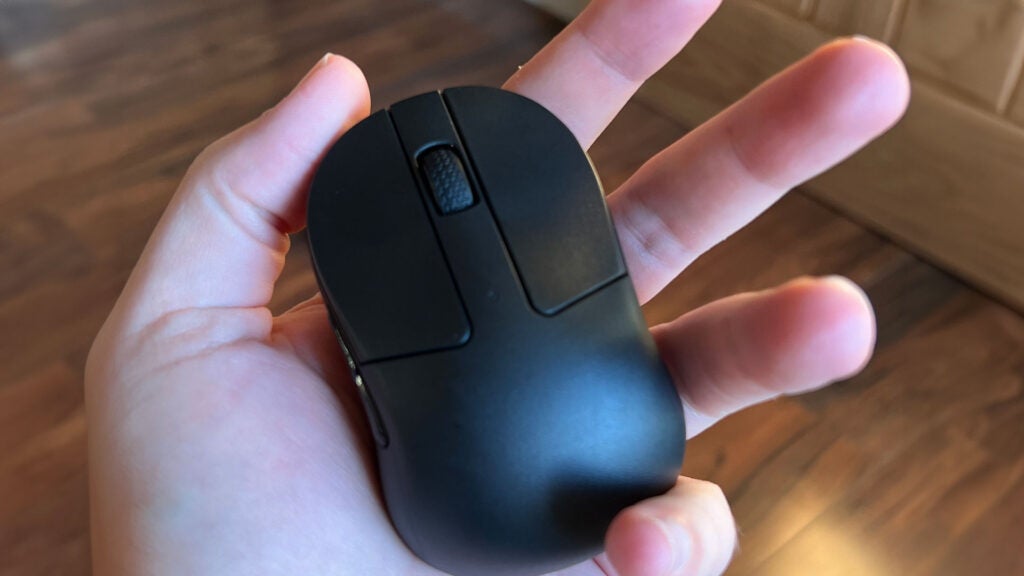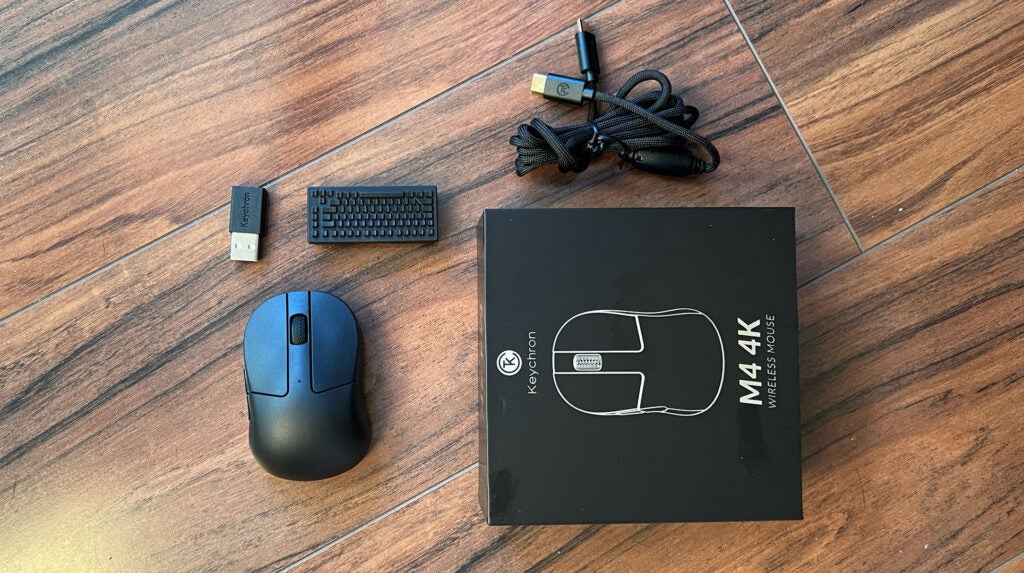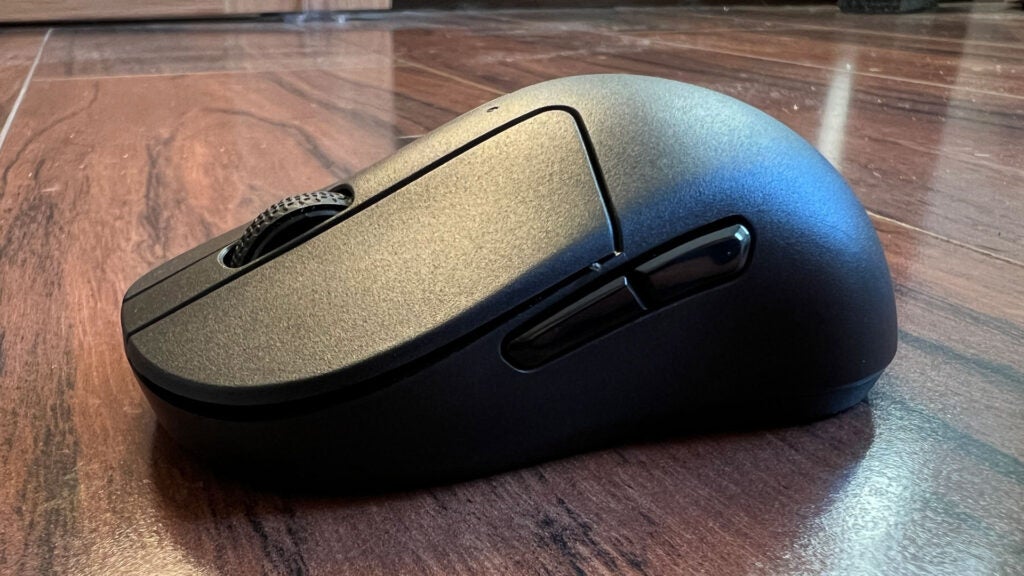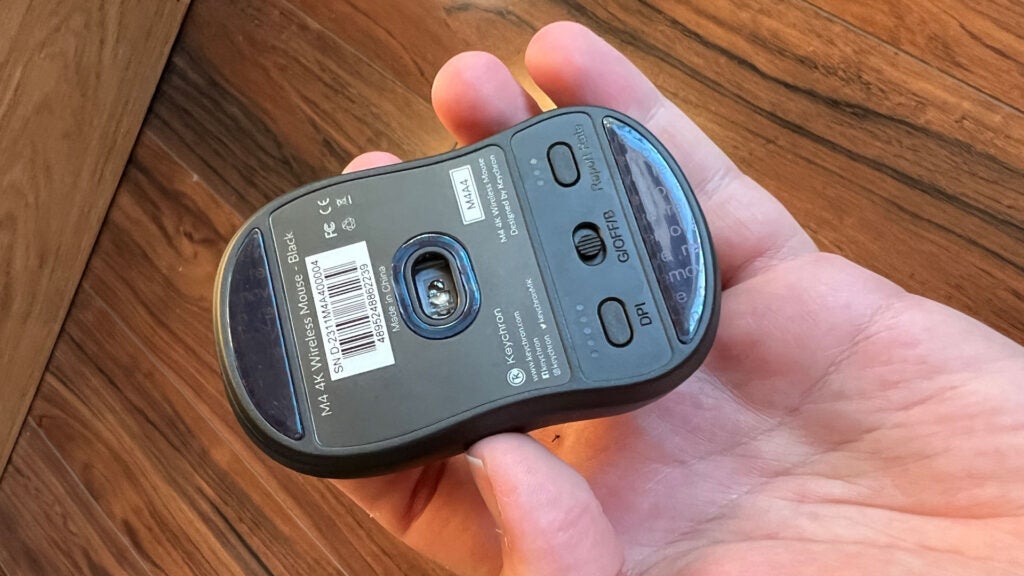Verdict
Not tiny by name but certainly tiny by design, the Keychron M4 4K isn’t quite a highly portable productivity peripheral, but it does rival some of the best gaming mice out there for a fraction of the price. Miraculously, it’s comfortable to boot.
Pros
- 4k sensor in a tiny package
- Bluetooth, wired, and 2.4Ghz wireless
Cons
- Connection can be spotty
- Receiver is just too big
- Portability means compromise
-
Tiny, adorable, cuteAt 32mm tall, the Keychron M4 4K is smaller than “Mini” mice in the range. -
Gaming-grade 4k sensorThe PixArt 3395 supports 26k DPI, 4,000Hz polling, and 650 IPS tracking. -
Fast, tactile switchesHuano switches allow for short, snappy, satisfying clicks.
Introduction
Perennial keyboard producer Keychron is now in on the mouse game and I’ve been impressed so far. The M6 was an unassuming mouse with excellent performance. For the Keychron M4 4K, a small size is the priority, for better and worse.
I’m also in the process of testing the Keychron M3 Mini wireless mouse and, oddly, it isn’t that small at all. It’s relatively low-profile compared to some other clickers out there, but it’s of average size at best. The one that isn’t mini by name? This M4 4K mouse is adorably tiny. Either way, my full review of the Keychron M3 Mini (Metal Edition) will be coming soon.
Confusion aside, the Keychron M4 4K is just as capable as its considerably larger, not-actually-mini counterpart but it may not stand up against key competitors or, even, in-house rivals like the M6. Let’s dive in.
Design
- Sturdy plastic chassis
- Matte black or white options
- Same ergonomics, tiny size
At just 35g, the Keychron M4 4K is technically one of the lightest gaming mice on the market. That’s already quite the selling point. But when it’s achieved by also being the smallest, the questions start to arise.
Available in either matt black or white finishes, both with ample texturing to its plastic chassis, the Keychron M4 4K isn’t the slippery bar of soap some much larger gaming mice on the market have proven to be. It slopes gracefully from the back to the front and its main clickers don’t ride down where your palm would sit.

It even maintains the two side buttons typically used for web browsing (or whacking a target with the butt of your gun). The M3 Mini’s buttons sometimes felt a little too small for its body. The M4 avoids shrinking them proportionality, making them generously large and easy to use by comparison.
The rear hides toggles and buttons to adjust connectivity, polling rate, between build-in profiles, and the PTFE feet, one stripped of their protective tape, glide along most surfaces as well as any other mouse. On the front is an inset USB-C port for charging or wired use, and that’s your lot.

What is mini about this whole package is the size of the box. Slide the top from the bottom and you’ll find the mouse, cable, and receiver nestled between thick foam.
It’s a very Keychron-type of package, but we’re still waiting for the day they shed the foam entirely. Cardboard will do. You could probably drop this off a building – a bit of a bump in a van isn’t going to be a problem.
Performance
- 4K sensor requires bulky receiver
- Surprisingly comfortable for gaming
- 1,000Hz when wired
Despite its miniature stature, the Keychron M4 is surprisingly comfortable in the hand. No part of the product page bills it as being a travel mouse; instead, Keychron doubles down by calling it comfortable, suitable for gaming, and perfectly placed on a desk.
And I’m inclined to believe them. After using it for a week, I honestly can’t see a major reason to go back to a full-sized alternative. It’s comfortable for long periods, the battery just keeps going, and it’s faster than most of the gaming mice out there.
With its novel keyboard-shaped receiver plugged into your setup, the Keychron M4 4K can hit – you guessed it – 4,000Hz polling thanks in part to its gaming-grade PixArt 3395 sensor. Unless you’re rocking a far above-average display with ultra-high refresh rates and resolution, you’re unlikely to need a more responsive mouse for a very long time.

There’s a 1k version of this same clicker with a much more manageable receiver, and with the Razer Viper V3 Hyperspeed managing to unlock 8k polling with its comparatively tiny Hyperpolling receiver, I have to hope Keychron is on the brink of offering something similar.
The keyboard-shaped dongle is cute, but it’s clunky and massively detracts from the portability of this particular product. Not to mention it’s far more prone to interference than the former; something we noticed with the 4k-equipped Keychron M3 as well.
Despite the potential shortcomings, most of what the Keychron M4 offers is sublime. The Huano switches are wonderfully short, snappy, and mechanically tactile, its tiny body lends itself to natural sturdiness, and its ultra-lightweight shape helps it glide along and welcome your quick wrist flicks in the moment.
Again, it looks like a clicker destined for the coffee shop office or designed to train a toddler in the art of no-scoping; but it’s ready for anyone. There’s little reason this couldn’t find its way into a pro player’s competition kit.
Software and Lighting
- No visible lighting
- Simple software suite
- Plenty of adjustable elements
When it comes to software and lighting, there’s very little to talk about. It’s where the Keychron M4 4K appears more like an ultra-portable clicker than it is.
Presumably to help the positivity precious 300mAh battery last only 22 hours in 4K mode, there’s no lighting to speak of. Not in the customizable sense, at least. A tiny array of LEDs on the base light up in different patterns to signify the DPI or polling rate you’ve selected. That’s your lot.

If you want to change what the Keychron M4 4K is capable of, you can wrestle your browser into trusting the Keychron Engine software download. Some still think it’s a threat.
Just as you can with the Keychron M3 Mini and Keychron M6, the engine software can let you dial in preferred DPI stages, enable angle snapping, adjust lift distance, and all that jazz. It’s easy enough to use, and it doesn’t look horrendous. But it’s nothing groundbreaking, either. It doesn’t need to be.
Latest deals
Should you buy it?
You want a space-saving gaming mouse with very compromises
Backing 4K polling potential in a tiny package, the Keychron M4 4K is ready to game whenever, wherever. Just remember to pack its unfortunately large receiver.
You want a pocketable gaming-grade clicker for work and play
Because of its annoying large dongle, you technically need to pack two devices for one job if you’re gaming on the go. Bluetooth at 125Hz won’t cut it.
Final Thoughts
If you’re in the market for a perfectly pocketable partner for your on-the-road office setup, the Keychron M4 4K isn’t the one. However, the company’s cheaper Keychron M6 alternative very well could be.
Powering its gaming-grade 4k polling potential is a clucky receiver that pleases on arrival with its cute keyboard shape but struggles in practice. It’s too large to set and forget in a port, requiring a cable (and potentially an adapter) to use and can’t be stowed on-device. It’s also sensitive to its environment, cutting out on a busy desk where smaller receivers rarely do.
In the rare case that you just want a tiny, wireless clicker for gaming at your desk (or potentially on your couch), it’s a great little piece of kit when it works. If you just need a travel mouse, the Logitech Pebble Mouse 2 M350s is the better buy. The Keychron M6, though certainly larger, is a gaming-grade productivity mouse whose specs make sense.
How we test
We use every mouse we test for at least a week. During that time, we’ll check it for ease of use and put it through its paces by playing a variety of different genres, including FPS, strategy and MOBAs.
We also check each mouse’s software to see how easy it is to customise and set up.
Used as a main mouse for over a week
Tested performance on a variety of games
FAQs
Yes, you can use the included USB-C/A cable and adapter to charge the mouse while using it in wired mode.
No, you only get the bulky 4,000Hz receiver in the box.
























